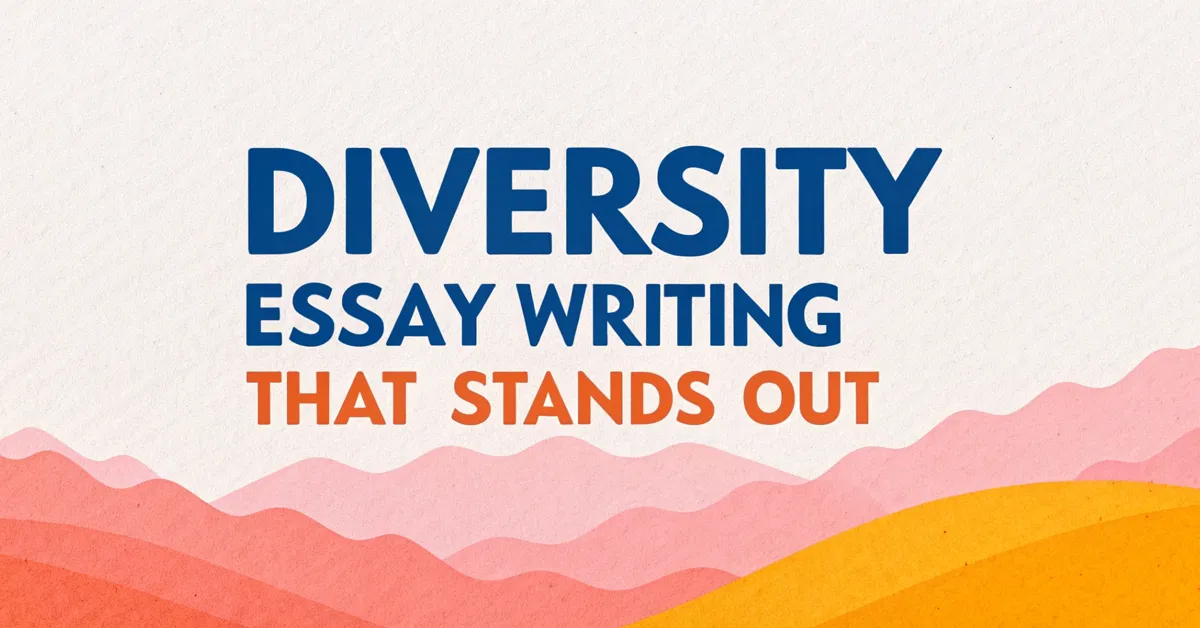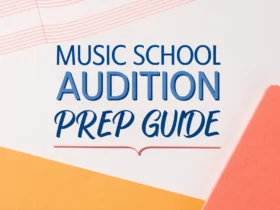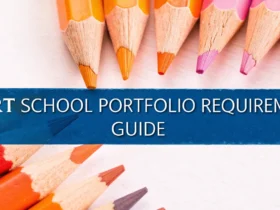Can a story truly capture who you are?
Crafting a college application is like assembling a mosaic, each piece reflecting a facet of your personality, achievements, and aspirations. Among these pieces, the diversity essay stands out—a space to share a unique perspective shaped by your background and experiences. But how do you write a diversity essay that truly stands out?
It can feel daunting. You want to be authentic, compelling, and insightful, all while staying within a limited word count. This article will show you how to navigate the diversity essay, transforming it from a potential hurdle into a powerful opportunity to showcase your individuality.
Here, you’ll learn the fundamentals of diversity essays and how to create an essay that is memorable.
What is a Diversity Essay?
The diversity essay is your chance to showcase what makes you unique and how your individual experiences and perspective can enrich the academic environment.
Colleges and universities seek to create vibrant, inclusive communities where students can learn from one another’s different backgrounds, cultures, and viewpoints. Your essay helps admissions committees understand how you would contribute to this diverse learning environment.
Diversity can encompass a wide range of factors, including but not limited to:
- Ethnic and cultural background: Your heritage, traditions, and cultural values.
- Socioeconomic status: Your experiences related to financial circumstances and opportunities.
- Gender identity and sexual orientation: Your experiences and perspectives related to your identity.
- Experiences with disability: Navigating challenges and offering unique insights.
- Unique life experiences: Overcoming adversity, pursuing unusual passions, or demonstrating resilience.
The key is to focus on how your background has shaped your perspective and what you can offer to the college community as a result. It’s not just about listing your differences, but about showing how those differences have made you a more thoughtful, empathetic, and engaged individual.
Why Colleges Want to Read Your Diversity Essay
Colleges and universities include the diversity essay in their application process because they’re looking to build more than just academically strong classes. They aim to cultivate dynamic communities where students learn not only from professors and textbooks but also from each other. By reading diversity essays, institutions hope to:
- Gain a Deeper Understanding of Applicants: Grades and test scores only tell part of the story. Diversity essays reveal applicants’ values, character, and how they make sense of the world around them.
- Evaluate Applicants’ Interpersonal Skills: Can you communicate effectively with people from different backgrounds? Are you open to new ideas and perspectives? The diversity essay helps admissions committees assess these crucial soft skills.
- Identify Potential Contributions to the College Community: How will you enrich discussions in the classroom? What unique perspectives will you bring to campus organizations? Colleges want to know how you’ll actively contribute to their community.
- Ensure a Well-Rounded, Inclusive Student Body: Diversity essays help institutions identify students who will help create a supportive, welcoming environment for everyone.
- Prepare Students for a Diverse World: By bringing together students from different backgrounds, colleges aim to prepare graduates for success in an increasingly interconnected and multicultural world.
How to Brainstorm Ideas for Your Diversity Essay
Before you start typing, take some time to brainstorm and identify the experiences and perspectives that are most meaningful to you. A good diversity essay is about more than just listing differences. It’s about revealing your unique take on the world. Here’s how you can brainstorm effectively:
-
Reflect on Your Background:
- Cultural Heritage: What traditions, values, or beliefs have shaped your upbringing?
- Family History: Are there stories or experiences from your family that have influenced your worldview?
- Socioeconomic Context: How has your financial background affected your opportunities and challenges?
-
Identify Key Experiences:
-
Challenges Overcome: What obstacles have you faced, and how have you grown from them?
- Unique Opportunities: Have you had experiences that have broadened your horizons or changed your perspective?
- Meaningful Relationships: Who are the people who have influenced you the most, and what have you learned from them?
-
Consider Your Perspective:
-
Values and Beliefs: What do you stand for? What principles guide your actions?
- Worldview: How do you see the world differently because of your experiences?
- Areas of Passion: What issues or topics are you most passionate about, and why?
-
Connect to College Goals:
-
Academic Interests: How does your unique background inform your academic pursuits?
- Extracurricular Activities: What clubs, organizations, or activities do you want to get involved in, and how will you contribute?
- Community Engagement: How do you plan to engage with the college community and contribute to its diversity?
-
Write Freely:
-
Once you’ve reflected on these questions, start writing without worrying about structure or grammar. The goal is to get your ideas down on paper (or screen) so you can start to see patterns and connections.
Tips for Effective Brainstorming:
- Be honest and authentic: The best essays come from the heart.
- Don’t be afraid to be vulnerable: Sharing your challenges can be powerful.
- Focus on growth and learning: Show how you’ve evolved because of your experiences.
- Connect your story to your goals: Show how your background informs your aspirations.
By following these steps, you can identify the unique aspects of your background and experiences that will make your diversity essay truly stand out.
Choosing the Right Story to Tell
The best diversity essays often tell a compelling story that highlights your unique background and perspective.
Selecting the right story is key to writing a great diversity essay. Not every experience is equal in weight or relevance. Consider the following factors when making your choice:
- Authenticity: Choose a story that is genuine and reflects your true self.
- Significance: Select an experience that had a meaningful impact on your life and shaped your perspective.
- Relevance: Ensure the story is relevant to the prompt and demonstrates how you would contribute to the college’s diverse community.
- Clarity: Pick a story that is easy to understand and allows you to clearly communicate your message.
- Originality: Aim for a story that is unique to you and sets you apart from other applicants.
Here are some examples of stories that work well for diversity essays:
- Overcoming a challenge: Facing discrimination, dealing with a disability, or navigating a difficult family situation.
- Embracing a cultural identity: Exploring your heritage, celebrating traditions, or bridging cultural gaps.
- Expanding your worldview: Traveling to a new country, volunteering in a different community, or engaging with people from different backgrounds.
- Pursuing a unique passion: Developing an unusual talent, challenging social norms, or advocating for a cause you believe in.
- Demonstrating leadership: Taking initiative, inspiring others, or creating positive change.
Stories to Approach with Caution
- Generic experiences: Avoid writing about common experiences like playing sports or participating in school clubs unless you can offer a unique and insightful perspective.
- Negative or complaining tone: Focus on growth, learning, and resilience rather than dwelling on negativity.
- Overly sensitive or controversial topics: Be mindful of your audience and avoid topics that could be offensive or alienating.
- Stories that exploit or sensationalize: Avoid exploiting your personal experiences for sympathy or attention.
Structuring Your Diversity Essay
A well-structured essay helps you communicate your ideas clearly and effectively. A good structure will make your essay shine. Here’s a simple format to follow:
-
Introduction:
- Hook: Start with an engaging sentence or anecdote that grabs the reader’s attention.
- Context: Provide some background information about your topic and your unique background.
- Thesis Statement: State the main point you want to make in your essay and how it relates to diversity.
-
Body Paragraphs:
-
Topic Sentence: Begin each paragraph with a clear topic sentence that introduces the main idea.
- Supporting Evidence: Provide specific examples, details, and anecdotes to support your claims.
- Analysis: Explain the significance of your experiences and how they have shaped your perspective.
- Transition: Use transition words and phrases to connect your ideas and create a smooth flow.
-
Conclusion:
-
Restate Thesis: Summarize your main point and its connection to diversity.
- Highlight Impact: Explain how your unique background and perspective would contribute to the college community.
- End with a memorable thought: Leave the reader with a lasting impression.
Example Structure:
- Introduction: Start with a vivid description of a cultural tradition you grew up with, then explain how it shaped your values and worldview.
- Body Paragraph 1: Describe a specific challenge you faced because of your cultural background, and how you overcame it.
- Body Paragraph 2: Explain how your cultural background has influenced your academic interests and career goals.
- Body Paragraph 3: Discuss how you plan to share your cultural perspective with the college community and contribute to its diversity.
- Conclusion: Reiterate your commitment to diversity and inclusion, and leave the reader with a powerful image or thought that reflects your unique cultural identity.
Writing with Authenticity and Vulnerability
Authenticity is the heart of any successful essay. Write with truth and honesty. Vulnerability shows your humanity. Here’s how to make your essay sound real:
- Share Your True Voice: Use language that feels natural to you.
- Be Honest About Your Experiences: Don’t embellish or exaggerate your stories.
- Acknowledge Your Emotions: Share how you felt during key moments in your story.
- Reflect on Your Growth: Show how you’ve learned and grown because of your experiences.
Here are some specific tips for writing with authenticity and vulnerability:
- Use “I” Statements: Speak from your own perspective and take ownership of your story.
- Share Specific Details: Bring your story to life with vivid details and sensory language.
- Don’t Be Afraid to Show Weakness: Sharing your vulnerabilities can make you more relatable.
- Focus on Your Journey: Highlight the transformation you’ve undergone.
Here are some examples of writing with authenticity and vulnerability:
- Instead of: “I am a strong and resilient person.”
- Try: “There were times when I felt like giving up, but I knew I had to keep going for my family.”
- Instead of: “I am a good leader.”
- Try: “I’ve made mistakes as a leader, but I’ve always tried to learn from them and do better next time.”
- Instead of: “I am a great student.”
- Try: “I’ve struggled with math, but I’m determined to improve and get the grades I want.”
Show, Don’t Tell
In the realm of effective writing, the principle of “show, don’t tell” is paramount. Rather than simply stating facts or characteristics, bring your story to life through vivid descriptions, sensory details, and specific examples. Here’s how to put this principle into action:
- Use Sensory Details: Engage the reader’s senses by describing what you saw, heard, smelled, tasted, and felt.
- Provide Specific Examples: Support your claims with concrete examples that illustrate your points.
- Create Vivid Images: Use descriptive language to paint a picture in the reader’s mind.
- Show, Don’t Tell: Rather than simply stating facts or characteristics, bring your story to life through vivid descriptions, sensory details, and specific examples.
- Write Dialogue: Use conversations to reveal character and advance the plot.
Here are some examples of showing versus telling:
- Telling: “I am a hardworking student.”
- Showing: “I would stay up late into the night, poring over textbooks and solving practice problems until I finally understood the material.”
- Telling: “I am a compassionate person.”
- Showing: “When I saw the homeless man shivering on the street corner, I gave him my coat and a warm drink.”
- Telling: “I am a creative artist.”
- Showing: “I would spend hours in my studio, mixing colors and experimenting with different techniques until I created a painting that expressed my vision.”
Connecting Your Story to College Goals
Your diversity essay isn’t just about sharing your background; it’s about demonstrating how your unique experiences and perspectives align with your goals and how you plan to contribute to the college community. Here’s how to make that connection:
-
Research the College:
- Learn about its mission, values, and diversity initiatives.
- Identify specific programs, clubs, or organizations that align with your interests.
-
Reflect on Your Goals:
-
What do you hope to achieve academically, personally, and professionally?
- How does your background inform your goals and aspirations?
-
Connect the Dots:
-
Explain how your unique background and perspective would enhance classroom discussions, campus life, and community engagement.
- Show how your experiences have prepared you to succeed in college and beyond.
-
Be Specific:
-
Avoid general statements about diversity and inclusion.
- Provide concrete examples of how you would contribute to the college community.
-
Be Authentic:
-
Don’t try to be someone you’re not.
- Share your genuine passions and interests.
Examples of connecting your story to college goals:
- “As a first-generation college student, I am passionate about helping other students from underserved backgrounds succeed in higher education. I plan to get involved in the college’s mentoring program to provide guidance and support to students who may be struggling.”
- “Growing up in a bilingual household has given me a unique perspective on language and culture. I am eager to join the college’s language club to share my knowledge and help other students learn about different cultures.”
- “Having overcome a disability has taught me the importance of perseverance and resilience. I am committed to advocating for disability rights on campus and creating a more inclusive environment for all students.”
Showcasing Your Writing Skills
While the content of your diversity essay is crucial, it’s equally important to showcase your writing skills. Your essay is not only a reflection of your unique background and perspective but also an indication of your ability to communicate effectively. Here’s how to make sure your writing is up to par:
-
Use Clear and Concise Language:
- Avoid jargon, clichés, and overly complex sentences.
- Get to the point and make your message clear and easy to understand.
-
Pay Attention to Grammar and Style:
-
Proofread your essay carefully to catch any errors in grammar, spelling, and punctuation.
- Use a consistent writing style and tone that reflects your personality and voice.
-
Use Transitions Effectively:
-
Use transition words and phrases to connect your ideas and create a smooth flow.
- Make sure each paragraph transitions logically to the next.
-
Vary Your Sentence Structure:
-
Use a mix of short and long sentences to keep your writing engaging.
- Avoid starting too many sentences with the same word or phrase.
-
End with a Strong Conclusion:
-
Summarize your main point and its connection to diversity.
- Leave the reader with a lasting impression.
Common Mistakes to Avoid
Even with careful planning and writing, it’s easy to make mistakes that can weaken your diversity essay. Here are some common pitfalls to avoid:
-
Being Too Generic:
- Avoid clichés and overused phrases that don’t reveal anything unique about you.
- Provide specific examples and details to support your claims.
-
Complaining or Blaming:
-
Focus on growth, learning, and resilience rather than dwelling on negativity.
- Avoid blaming others for your challenges or setbacks.
-
Exploiting or Sensationalizing:
-
Avoid exploiting your personal experiences for sympathy or attention.
- Be respectful of your audience and avoid sharing overly sensitive or controversial information.
-
Writing About Someone Else:
-
Focus on your own experiences, perspectives, and goals.
- Avoid writing about someone else’s story unless it directly relates to your own.
-
Exaggerating or Lying:
-
Be honest and authentic in your writing.
- Don’t embellish or exaggerate your accomplishments or experiences.
-
Failing to Connect to College Goals:
-
Explain how your unique background and perspective would contribute to the college community.
- Show how your experiences have prepared you to succeed in college and beyond.
-
Ignoring the Prompt:
-
Carefully read and understand the prompt before you start writing.
- Make sure your essay addresses all aspects of the prompt and stays within the word limit.
Reviewing and Editing Your Essay
Once you’ve written your diversity essay, take the time to review and edit it carefully. This is your chance to polish your writing, strengthen your message, and eliminate any errors or weaknesses. Here are some steps to follow:
-
Take a Break:
- Step away from your essay for a few hours or days to gain a fresh perspective.
- This will help you identify areas that need improvement.
-
Read Aloud:
-
Read your essay aloud to catch any awkward phrasing, grammatical errors, or inconsistencies in tone.
- This will also help you identify areas where your writing could be more engaging or compelling.
-
Get Feedback:
-
Ask a trusted friend, teacher, or mentor to read your essay and provide feedback.
- Be open to criticism and consider their suggestions for improvement.
-
Focus on Clarity and Conciseness:
-
Make sure your message is clear, concise, and easy to understand.
- Eliminate any jargon, clichés, or overly complex sentences.
-
Check for Grammar and Spelling Errors:
-
Proofread your essay carefully to catch any errors in grammar, spelling, and punctuation.
- Use a grammar and spelling checker to identify any mistakes you may have missed.
-
Ensure Relevance and Authenticity:
-
Make sure your essay answers the prompt directly.
- Review whether you expressed yourself authentically.
-
Refine Your Conclusion:
-
Make sure your conclusion summarizes your main point.
- Write your essay end with a lasting impression.
-
Final Proofread:
-
Review your essay for errors.
- Ensure every word resonates.
Diversity as Your Strength
Diversity is not a hurdle but an asset that you can leverage to enrich your college experience. To reiterate, you should:
- Highlight how your background will inform your academic interests and contributions.
- Share how your experiences have honed your interpersonal and problem-solving skills.
- Show how your unique perspective will contribute to a richer, more inclusive campus.
Your journey is your strength; your story, your voice.
Ready to Write?
The diversity essay offers a chance to show admissions committees who you are and what you value. By choosing the right story, structuring your essay effectively, and writing with authenticity and vulnerability, you can create a compelling and memorable piece that highlights your unique background and perspective.
Diversity is a mosaic of experiences and insights. Embrace your uniqueness, tell your story, and watch as it adds color to the vibrant community you’re about to join.















Leave a Reply
View Comments